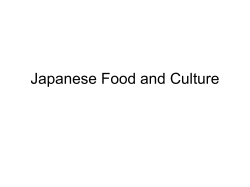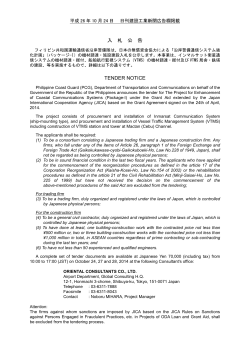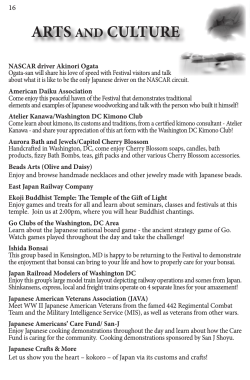
JAPANESE COOKING By Tamara Pottrick and Tia Kooner
JAPANESE COOKING By Tamara Pottrick and Tia Kooner The Ancient History of Cooking In 400 BC, Korea introduced the first main food to Japan, which was ご はん and in 300 BC the second staple food for Japan was introduced by China, which was なっと, the soy bean By the 6th century, Buddhism became part of the Japanese culture, bringing the law of not eating さかな and any type of にく, which lasted for 1200 years, any person who broke this rule was sentenced to death, though the emperor who brought these rules did not ban deer or wild boar for food When the Europeans came in the 16th century, they brought western fried foods, sugar, and corn History of Japanese Cooking The 8th century saw more change as the killing of animals and ban of fishing occurred At this time, chopsticks and dining tables were introduced from China to Japan After the めいじ Restoration in 1867 (9th century), meat and fish were reintroduced to Japanese culinary and banquets were held frequently with all kinds of foods During the かまむら period, japanese cuisine took on more of a flavourful change, with the ほんぜん りより ( banquet held for warriors, with jellyfish, pickled ume and many other foods) banquet becoming more popularized The vegetarian philosophy grew stronger during this time, those who killed animals were discriminated against by Buddhists and Shintos Modern Day Cooking Modern day cooking is still influenced by geography and seasons with seafood and veggies the most common foods Dishes are based on the staple foods of Tofu, fish, meat and veggies Freshness, presentation, and balance of flavours are very important in Japanese culinary Meals always include ごはん and certain soups (mostly みそ, though), but with few dairy products すし and すしみ (raw fish) are often ate at the beginning of a meal Dessert is rarely served with the exception of fresh くだもの on occasions Modern Day Cooking Continued • Strictly Vegetarian foods are rare in Japan since even vegetable dishes have shipjack tuna flakes on them • Though there is an exception on しょうじん りようり a vegetarian dish created by Japanese monks • Noodles are a very important part of japanese cuisine as an alternative to rice • そば and うどん are the main traditional noodles that can be served either hot or cold, also Chinese-style noodles called ら めん , served in meat stock, have become very popular over the past century Japanese Restaurants There are about 15 different types of restaurants that specialize in different types of Japanese foods –e.g. すしーや specializes in sushi; かいてんーずし specializes in sushi on a conveyor belt; and そばーや specializes in そば and うどん noodles You must take off your shoes before entering, and sit at low tables, on cushions おはし are set in a box in the middle of the table They display plastic or wax replicas of each dish sold in the restaurant Japanese Restaurants • It is not expected to tip waiters, and they may chase you to give you back the change you left behind • At some restaurants, you are required to buy meal tickets before hand, which you hand to the staff and they serve you, what you had previously bought. • As soon as you are seated at your table, you are handed a glass of tea, a hot towel and a bowl of みそ soup as an appetizer, as well as to drink throughout the meal • The Bill is brought to you either while you are eating, or as soon as you finish Common Foods やきもの (yakimono): Grilled and pan fried にもの (nimono): stewed or simmered dish いためもの (itamemono): stir-fried dishes むしもの (mushimono): steamed dishes Traditional and common Japanese Sweets わがし (wagashi): Japanese-styles sweets だがし (dagashi): Old fashioned Japanese sweets かし ぱん (kashi pan): A sweet type of bread Cooking Tools • はんぎり (hangiri): A rice barrel that is used in the final step to prepare rice for すし used to dress and cool the rice • おはし (ohashi): One of the main cooking tools, used to stir, eat and many other uses • どねべ (donebe): A ceramic pot that Is used on top of an open flame • あげもの なべ (agemono nabe): A [pot used for deep fryng foods • まきやきなべ (makiyakinabe): A small, rectangular, metal pan used to make Japanese omelettes Cooking Tools Continued • ざる (Zaru): A bamboo draining basket • いき じめ (Iki Jime): A spike used on a fish’s brain • There are around 10 different types of knives used for cooking, a few of them are: • さんとく (santoku): a general-purpose flat knife with a sheepsfoot blade, used to cut meat, vegetables and fish • うどんきり (udonkiri): A specialized knife used to make うどん and そ ば • でばぼちょ (deba bocho): A kitchen knife, used to carve fish, chicken and other meats, which first appeared during the Edo period (1603) in さ かい, おうさか Dining Etiquette • At the beginning of a meal, you are given a hot towel to wash you hands. It is only to be used at the beginning and is considered rude to use it on any other body part. • It is customary to say いただきます at the beginning of each meal • Bowls are often picked up with your left hand, and your chopsticks with the right, to avoid any elbow bumping. • Only bowls of soup are lifted to the mouth, not white rice. • Chopsticks are never to be left sticking up vertically from the rice bowl, because it resembles the placing of incense sticks in the sand during offerings to the dead. Dining Etiquette Continued • Soy sauce is never poured on rice or soup and all noodles are slurped • When taking from a communal dish at the table, switch your chopsticks around to be sanitary • Being a fussy eater is frowned upon in Japan, especially during a business meeting, it is being ungrateful towards your host. • All times when drinking, it is started with a toast, and is considered polite to hold your glass with both hands when your drink is being poured, and not to pour your drink yourself Menu あさごはん includes the essentials of みそ soup, さかな, ごはん, japanesepickles, のり (dried seaweed) and raw egg to mix with the ごは ん ひるごはん are usually in the form of an Obentoo, which is a boxed lunch with various different foods, like rice or onigiri, meat, egg, vegetables, and sometimes sushi ばんごはん traditionally consists of miso soup, rice, Natto (soy beans), and baked fish These are only a few of the combinations that you would typically eat in a Japanese restaurant or household Bibliography http://www.geocities.co.jp/AnimalParkShiro/7757/dinner.html www.recipes4us.co.uk/Cooking%20by%20 country/Japan.htm www.about.com www.japan-guide.com/e/e2036.html http://en.wikipedia.org/wiki/Japanese_cuisi ne http://en.wikipedia.org/wiki/List_of_Japanes e_cooking_utensils Pictures
© Copyright 2025











